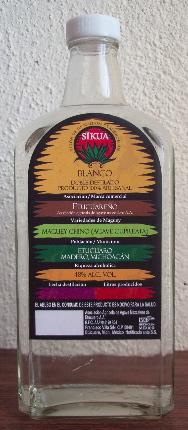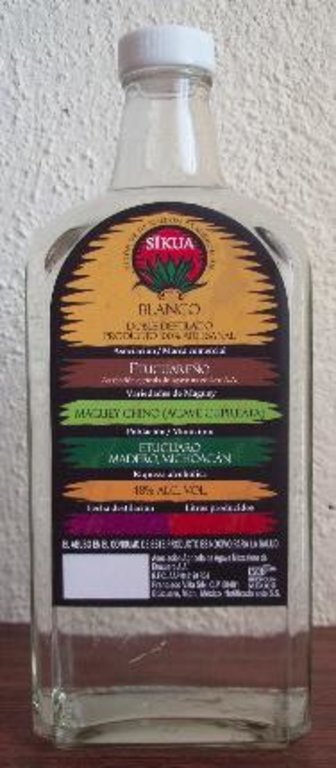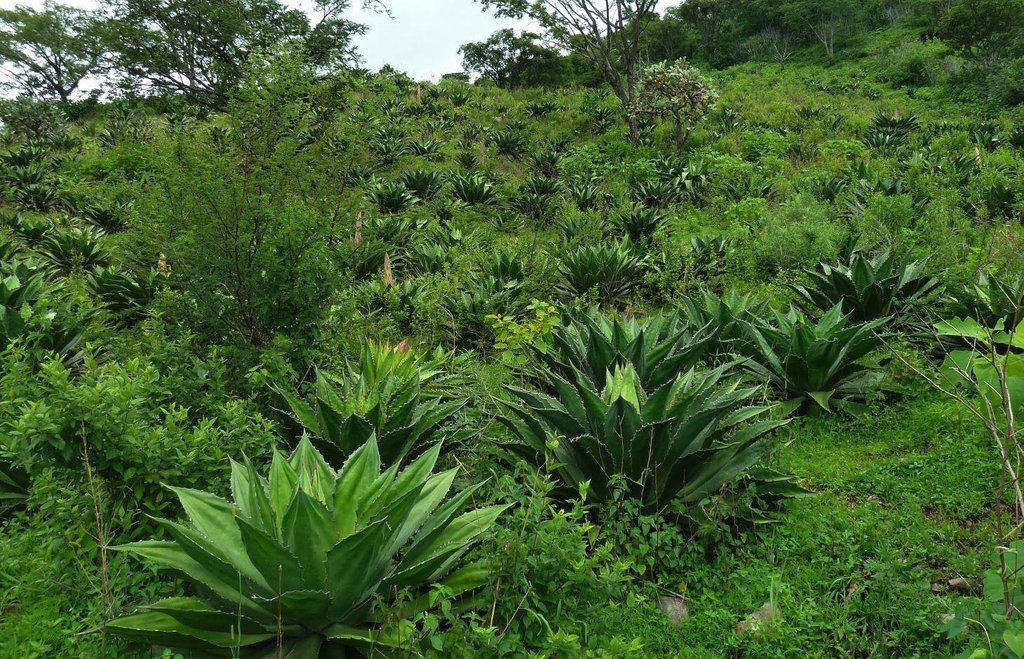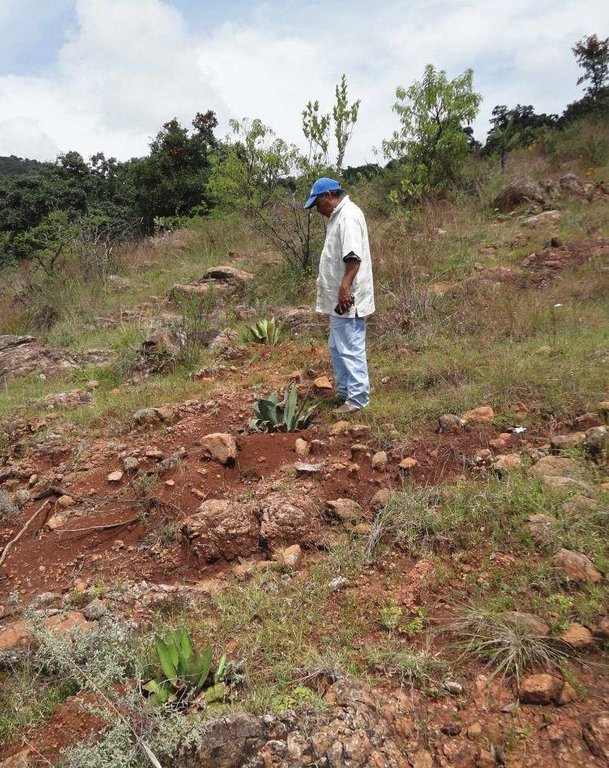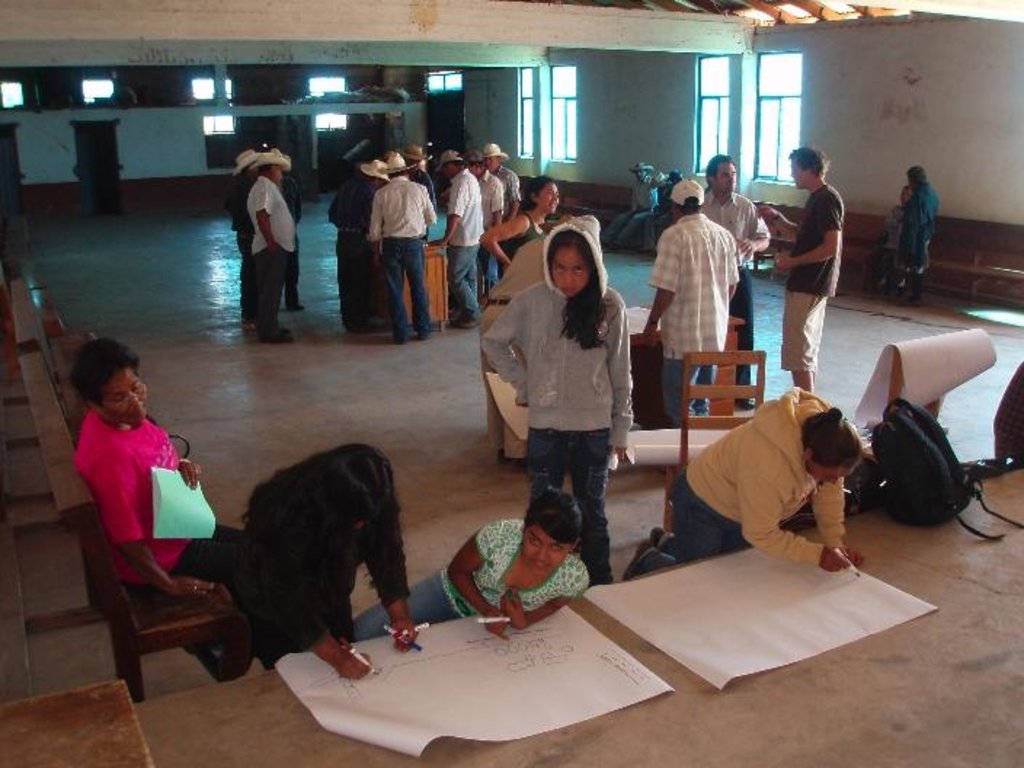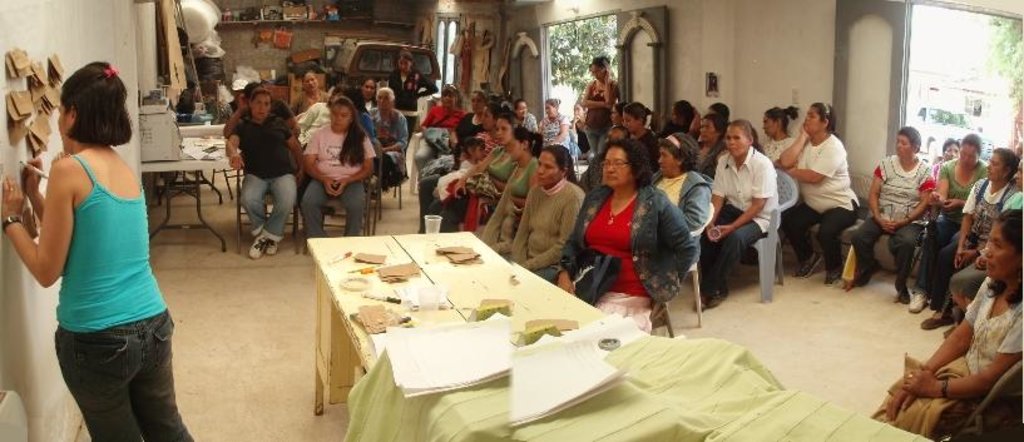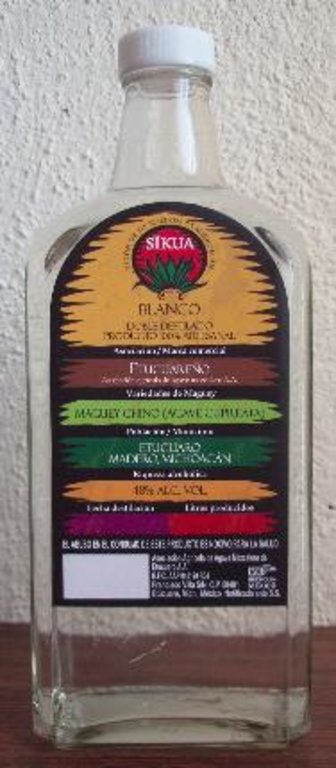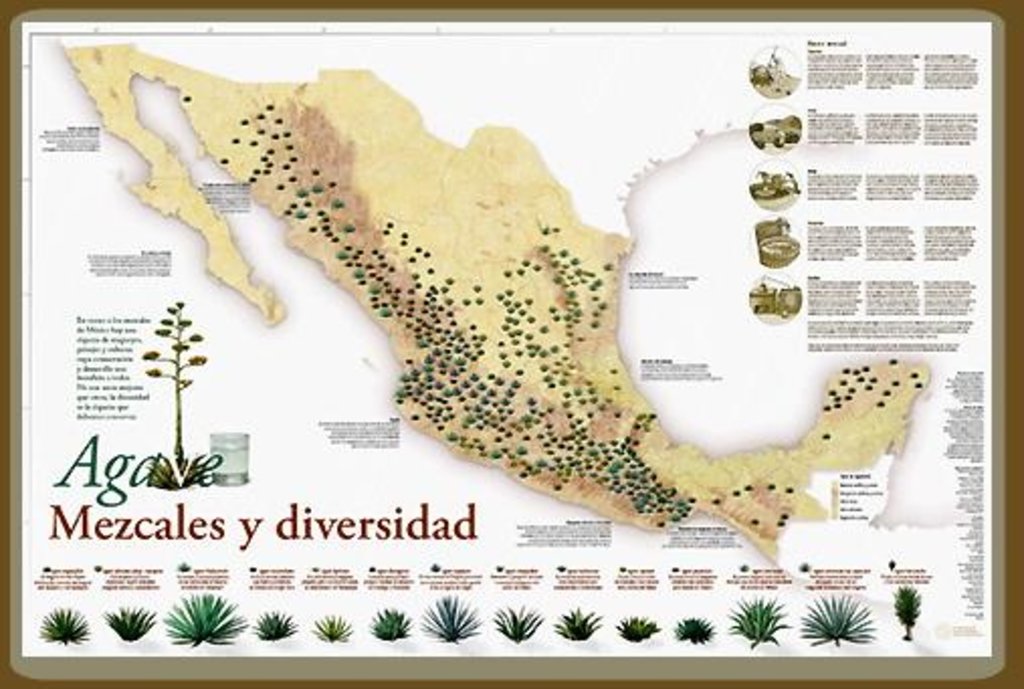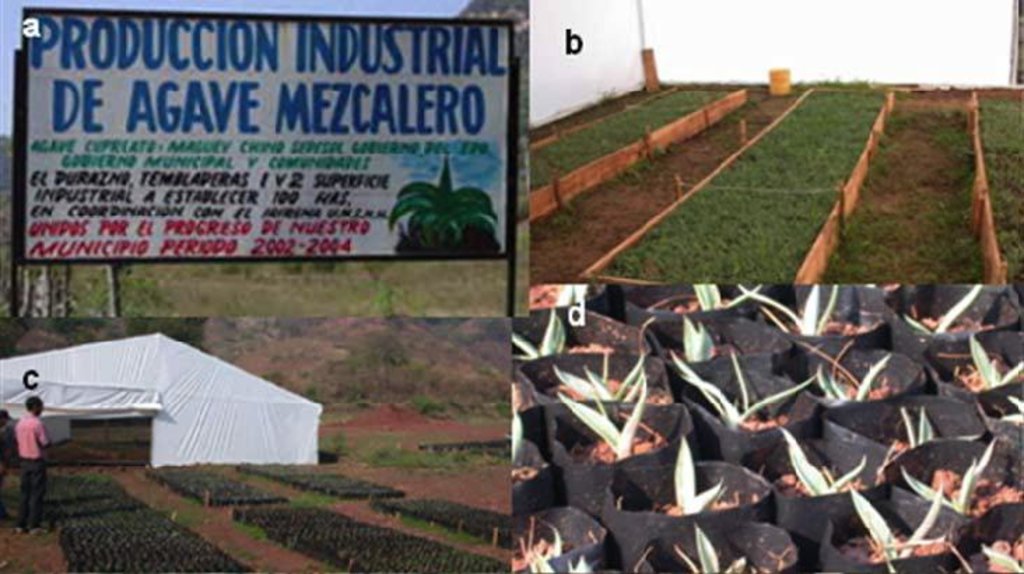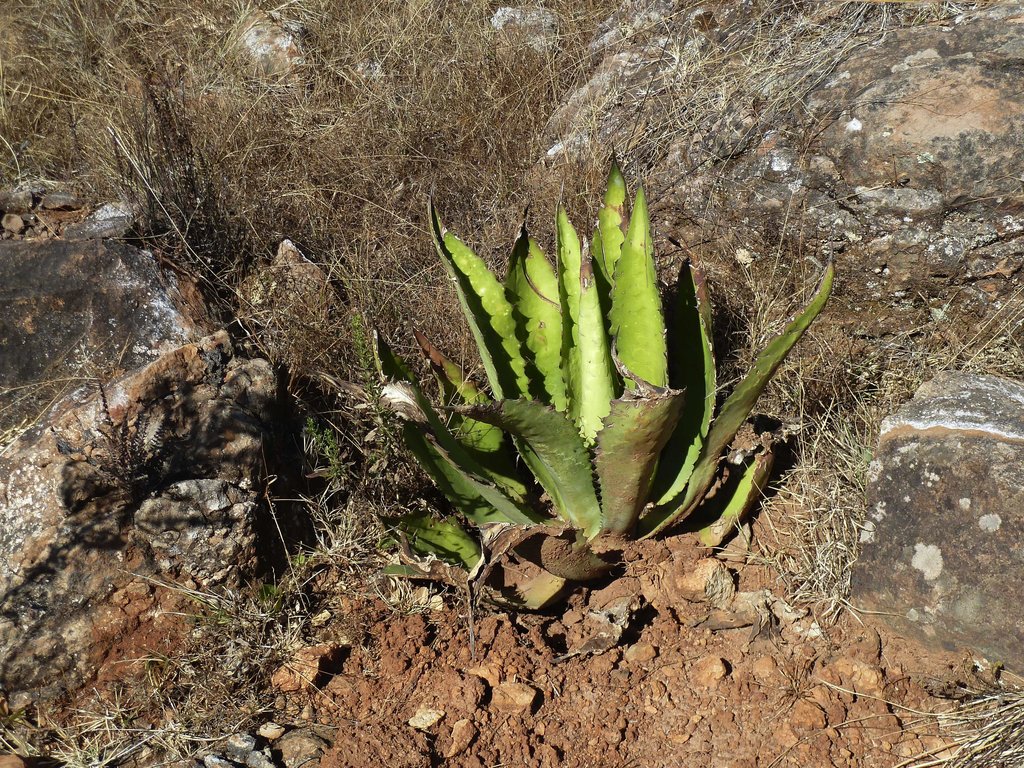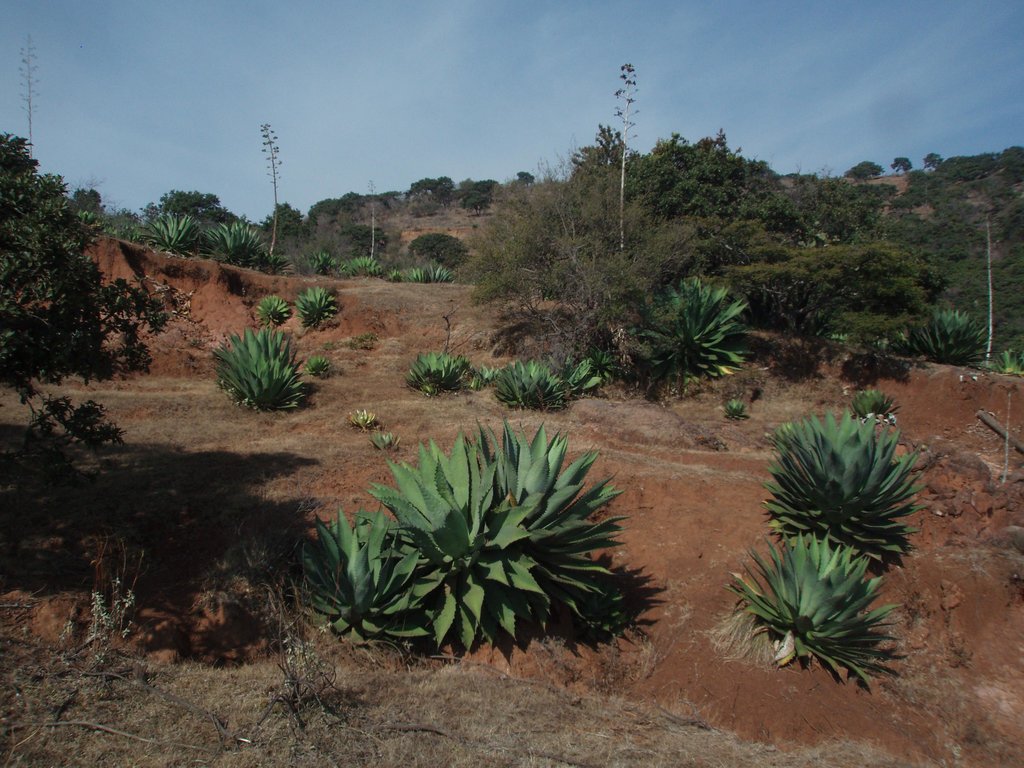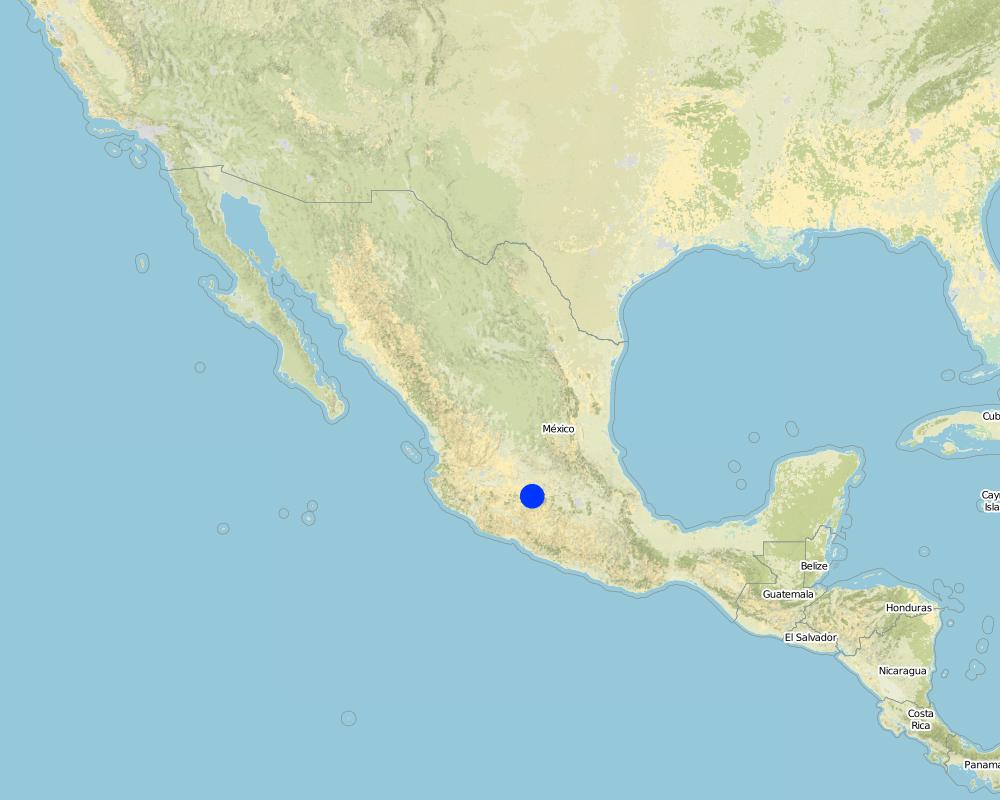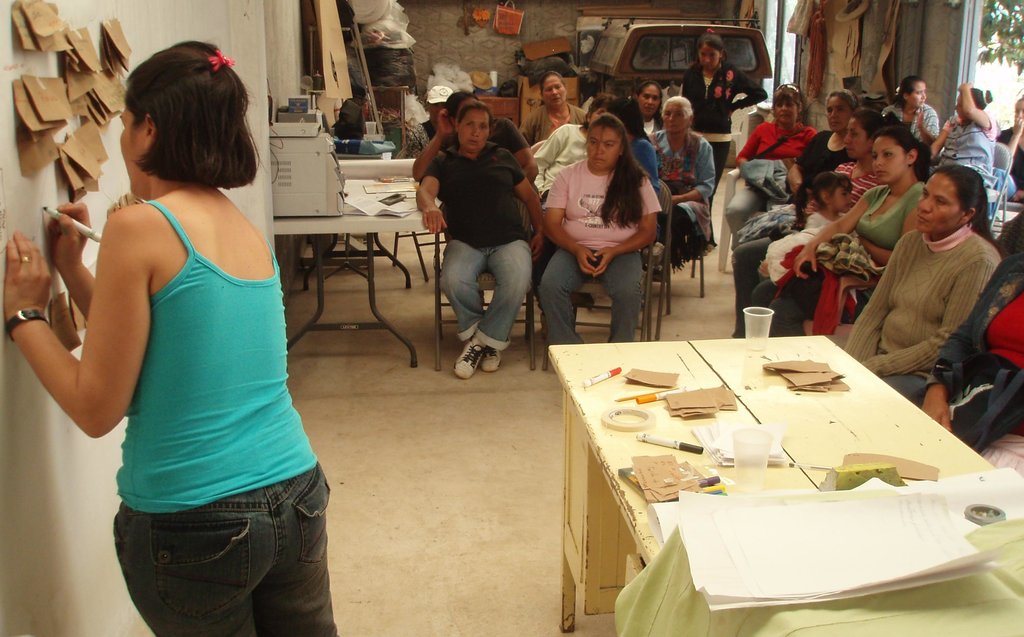Participative actions for economic benefits of agave forestry [ແມັກຊີໂກ]
- ການສ້າງ:
- ປັບປູງ:
- ຜູ້ສັງລວມຂໍ້ມູນ: Christian Prat
- ບັນນາທິການ: –
- ຜູ້ທົບທວນຄືນ: Fabian Ottiger
Recuperación de tierras degradadas por agaveforestería a través de acciones participativas para beneficios económicos (Spanish)
approaches_2436 - ແມັກຊີໂກ
ເບິ່ງພາກສ່ວນ
ຂະຫຍາຍທັງໝົດ ຍຸບທັງໝົດ1. ຂໍ້ມູນທົ່ວໄປ
1.2 ລາຍລະອຽດ ການຕິດຕໍ່ ຂອງບຸກຄົນທີ່ຊັບພະຍາກອນ ແລະ ສະຖາບັນ ການມີສ່ວນຮ່ວມ ໃນການປະເມີນຜົນ ແລະ ເອກະສານ ຂອງວິທີທາງ
ຜູ້ຊ່ຽວຊານ ດ້ານການຄຸ້ມຄອງ ທີ່ດິນແບບຍືນຍົງ:
Martínez Palacios Alejandro
Tel (443) 334-0475, Ext. 119
apalacios56@gmail.com
Instituto de Investigaciones Agropecuarias y Forestales, Universidad Michoacana de San Nicolás de Hidalgo (IIAF-UMSNH)
Morelia-Zinapecuaro, Tarímbaro, Michoacán 58330, México
ແມັກຊີໂກ
ຜູ້ຊ່ຽວຊານ ດ້ານການຄຸ້ມຄອງ ທີ່ດິນແບບຍືນຍົງ:
Ríos Patrón Eduardo
01 (443) 3226017
eduardo.rios@semarnat.gob.mx
Delegación de SEMARNAT (Secretaria del Medio Ambiente) en Michoacán, Unidad de Planeación y Política Ambienta
Morelia, Michoacán
ແມັກຊີໂກ
ຊື່ຂອງໂຄງການ ທີ່ອໍານວຍຄວາມສະດວກ ໃນການສ້າງເອກກະສານ ຫຼື ປະເມີນດ້ານແນວທາງ (ຖ້າກ່ຽວຂ້ອງ)
DESIRE (EU-DES!RE)ຊື່ຂອງ ສະຖາບັນການຈັດຕັ້ງ ທີ່ອໍານວຍຄວາມສະດວກ ໃນການສ້າງເອກກະສານ ຫຼື ປະເມີນແນວທາງ (ຖ້າກ່ຽວຂ້ອງ)
Institut de recherche pour le développement IRD (Institut de recherche pour le développement IRD) - ຝຣັ່ງຊື່ຂອງ ສະຖາບັນການຈັດຕັ້ງ ທີ່ອໍານວຍຄວາມສະດວກ ໃນການສ້າງເອກກະສານ ຫຼື ປະເມີນແນວທາງ (ຖ້າກ່ຽວຂ້ອງ)
Instituto de Investigaciones Agropecuarias y Forestales (IIAF) - ແມັກຊີໂກຊື່ຂອງ ສະຖາບັນການຈັດຕັ້ງ ທີ່ອໍານວຍຄວາມສະດວກ ໃນການສ້າງເອກກະສານ ຫຼື ປະເມີນແນວທາງ (ຖ້າກ່ຽວຂ້ອງ)
SECRETARÍA DE MEDIO AMBIENTE Y RECURSOS NATURALES (SECRETARÍA DE MEDIO AMBIENTE Y RECURSOS NATURALES) - ແມັກຊີໂກ1.3 ເງື່ອນໄຂ ຂອງການນໍາໃຊ້ເອກກະສານຂໍ້ມູນ ຂອງ WOCAT
ຜູ້ສັງລວມ ແລະ ບັນດາຜູ້ຕອບແບບສອບຖາມ ຍອມຮັບໃນເງື່ອນໄຂ ການນໍາໃຊ້ຂໍ້ມູນເອກະສານ ທີ່ສ້າງຂື້ນ ໂດຍຜ່ານ ອົງການ WOCAT:
ແມ່ນ
1.4 ເອກະສານອ້າງອີງ (ຫຼາຍ) ກັບແບບສອບຖາມ (ຫຼາຍ) ເຕັກໂນໂລຢີ ຂອງດ້ານການຄຸ້ມຄອງ ດິນແບບຍືນຍົງ

Land reclamation by agave forestry with native species [ແມັກຊີໂກ]
Agave forestry land reclamation system with native agaves, trees, shrubs and grasses planted through participatory action for a sustainable production of mezcal and other products in order to generate high incomes for farmers.
- ຜູ້ສັງລວມຂໍ້ມູນ: Christian Prat
2. ພັນລະນາ ແນວທາງການຄຸ້ມຄອງນໍາໃຊ້ດິນແບບຍືນຍົງ
2.1 ການອະທິບາຍ ໂດຍຫຍໍ້ ຂອງວິທີທາງ
Land reclamation with local agave (to produce Mezcal) associated with trees, shrubs and grasses planted through participative actions for economic benefit.
2.2 ການອະທິບາຍ ລາຍລະອຽດ ຂອງວິທີທາງ
ການອະທິບາຍ ລາຍລະອຽດ ຂອງວິທີທາງ:
Aims / objectives: Rehabilitation of degraded land is achieved by using native agave (Agave inaequidens) and trees, shrubs and grasses which creates, over the medium-term (7-10 year), a sustainable production of an alcoholic drink (mezcal) and/or pharmaceutical products and/or fodder for cattle and/or wood. Further objectives are water conservation, biodiversity, generation of permanent employment (plant reproduction, planting, alcoholic drink/ pharmaceutical production), carbon sequestration, generation of higher family incomes and a reduction in the amount of livestock and number of animals and uncontrolled grazing (the main cause of soil erosion). These positive impacts of the approach contribute to preventing the rural population from emigrating to the cities or abroad.
Methods: Coordination, cooperation and systematic participatory process among stakeholders are the basis of the approach. Promoting participatory processes occurs through workshops, interviews with community leaders, field visits conducted with owners of the land to recognize the problems and identify areas of opportunity, training courses, exchange of experiences with other people who are developing similar projects at different stages. Technical advice and the links with scientists, technicians and public officials in charge of project beneficiaries is given under a two-way process of mutual learning and seeking to strengthen self-management capabilities that inspires innovation at the different stages. The key to success of a participatory approach lies in liberating and developing community leadership and self-organization processes.
Stages of implementation: The project is part of a regional planning context and a basin scale approach of intervention. The watershed of the site project is included in a special programme of the Ministry of Environment and Natural Resources of Mexico which gives the opportunity of developing and financing a medium- to long-term project. The participatory process is delivered from planning, organizing, programming and implementing to financing, training, monitoring and disseminating the results. The strategic perspective of the project includes capacity-building of land owners for greenhouse and nursery management, the technical assessment for the improvement of the agave forestry system, guidance with quality production of mezcal and marketing support to diversify products and sell them in order to make the project financially self-sustaining and profitable. All these stages range from short- to medium- and long-term.
Role of stakeholders: The government finances the project through grant resources, promotes the participation of beneficiaries and monitors it, seeking the management of resources and intersectoral participation. Scientists and academics share their knowledge, techniques and methodologies for implementation, improvement, evaluation and monitoring of each stage, and they support capacity-building of the community. The owners of the land and the community implement and develop each of the activities from building and maintaining the greenhouse and nursery, planting agaves, trees and shrubs, to the use and production of mezcal and other commercial products.
2.3 ຮູບພາບຂອງແນວທາງ
2.5 ປະເທດ / ເຂດ / ສະຖານທີ່ບ່ອນທີ່ແນວທາງໄດ້ຖືກນໍາໃຊ້
ປະເທດ:
ແມັກຊີໂກ
ພາກພື້ນ / ລັດ / ແຂວງ:
Mexico/Michoacán state
ຂໍ້ມູນເພີ່ມເຕີມຂອງສະຖານທີ່:
Morelia
Map
×2.6 ວັນທີເລີ່ມຕົ້ນ ແລະ ສິ້ນສຸດ ການຈັດຕັ້ງປະຕີບັດ ວິທີທາງ
ສະແດງປີຂອງການເລີ່ມຕົ້ນ:
2009
ປີທີ່ສີ້ນສູດ (ຖ້າຢຸດບໍ່ໄດ້ນໍາໃຊ້ ວິທີທາງ):
2012
2.7 ປະເພດຂອງແນວທາງ
- Traditional, innovative and project based
2.8 ເປົ້າໝາຍ / ຈຸດປະສົງຫຼັກ ຂອງການຈັດຕັ້ງປະຕິບັດ ວິທີທາງ
The Approach focused mainly on other activities than SLM (registered alcohol production, cattle fodder, medicine uses, biodiversity conservation, wood)
Rehabilitation of degraded land is done using native agave (Agave inaequidens), trees, shrubs and grasses which creates, over the medium-term (7-10 years) sustainable production of an alcoholic drink (mezcal) and/or pharmaceutical products and/or fodder for cattle and/or wood.
The SLM Approach addressed the following problems: Social and economic problems: Agriculture and livestock in the region are primarily for subsistence. The level of poverty and marginalization of the people of the project site is medium to high with low education levels. People need to migrate to the cities or outside the country to supplement the family budget. Prices of farmer productions are too low and do not allow economic survival. Therefore, only 10 to 20% of the total incomes are derived from agricultural products! This explains why the children of farmers do not want to become farmers and lands are less and less cultivated. In correlation, as the livestock price is good and animals can be raised with little input of time. Thus the number of animals is increasing and as they are grazing everywhere, they have a strong soil erosion impact.
2.9 ເງື່ອນໄຂອໍານວຍ ຫຼື ຂັດຂວາງການປະຕິບັດຂອງເຕັກໂນໂລຢີ / ເຕັກໂນໂລຢີການນໍາໃຊ້ຕາມແນວທາງ
ສັງຄົມ / ວັດທະນະທໍາ / ມາດຕະຖານ ແລະ ຄຸນຄ່າທາງສາສະໜາ
- ເຊື່ອງຊ້ອນ
The social arrangement of the “ejido” requires all people to agree on moving forward with different activities. The level of education and migration.
Treatment through the SLM Approach: Systematic and constant promotion of the participatory process through community assembly meetings, workshops, community exchange travel, experiences and training. Promote complementarity and targeting of resources from other sectors.
ມີຄວາມສາມາດ / ເຂັ້າເຖິງຊັບພະຍາກອນດ້ານການເງິນ ແລະ ການບໍລິການ
- ເຊື່ອງຊ້ອນ
Potential constraints in the final stages of the project when receiving revenue from the sale of mezcal and other products.
Treatment through the SLM Approach: Strengthening capacities of organization and administration, promoting transparency and accountability in the community. Development and consolidation of the formation of cooperatives as an alternative to social enterprise.
ການກໍ່ຕັ້ງສະຖາບັນ
- ເຊື່ອງຊ້ອນ
The risk that the six-year change in administration does not follow the care programme in the area.
Treatment through the SLM Approach: Strengthening self-management capabilities of the group of beneficiaries of the project. Involving other government levels and sectors funding training and monitoring of subsequent stages.
ກ່ຽວກັບກົດໝາຍ (ສິດນໍາໃຊ້ດິນ, ສິດນໍາໃຊ້ນໍ້າ)
- ອໍານວຍ
The existing land ownership, land use rights / water rights greatly helped the approach implementation
- ເຊື່ອງຊ້ອນ
Federal, state and municipal regulations for preventing clearance of woods, biodiversity uses, forest exploitation, water concessions and water quality must be applied. Mexican official standards of mezcal production must be used
Treatment through the SLM Approach: Conduct a thorough review with a focus on prospective different stages of a project and the legal implications and regulations that must be met at these stages. Inform land owners about their rights, obligations and mechanisms of fulfilment.
ຄວາມຮູ້ກ່ຽວກັບການຄຸ້ມຄອງ ທີ່ດິນແບບຍືນຍົງ, ການເຂົ້າເຖິງການສະໜັບສະໜູນ ທາງດ້ານວິຊາການ
- ເຊື່ອງຊ້ອນ
Lack of validation and technology transfer of agave forestry. Lack of information on the requirements of these species of agave. Potential risk to move from non-intensive system to an intensive one due to economic and market factors.
Treatment through the SLM Approach: Development of technological packages for an agave forestry system as a basis for the production of mezcal, considering soil erosion levels and system arrangements. Promote only ecologically diversified, non-intensive systems. Design environmental and ecological monitoring stage.
3. ການມີສ່ວນຮ່ວມ ແລະ ບົດບາດຂອງພາກສ່ວນທີ່ກ່ຽວຂ້ອງທີ່ໄດ້ມີສ່ວນຮ່ວມ
3.1 ຜູ້ມີສ່ວນຮ່ວມ ໃນວິທີທາງ ແລະ ພາລະບົດບາດ ຂອງເຂົາເຈົ້າ
- ຜູ້ນໍາໃຊ້ດິນໃນທ້ອງຖິ່ນ / ຊຸມຊົນທ້ອງຖິ່ນ
Traditionally, women have been more responsible for the house and the area close to it. They are less involved in the field activities of the agave forestry project, but are involved in production and commercialization. On the other hand, women are worried about the possible impacts of alcoholic drink on communities, because alcoholism is a social concern. There has been no discrimination inside the communities up to now
- ຜູ້ຊ່ຽວຊານ ການນຄຸ້ມຄອງ ທີ່ດິນແບບຍືນຍົງ / ທີ່ປຶກສາດ້ານກະສິກໍາ
- ຄູອາຈານ / ນັກຮຽນ / ນັກສຶກສາ
- ພາກເອກະຊົນ
- ອໍານາດ ການປົກຄອງທ້ອງຖິ່ນ
- ພະນັກງານຂັ້ນສູນກາງ (ຜູ້ວາງແຜນ, ຜູ້ສ້າງນະໂຍບາຍ)
- ອົງການຈັດຕັ້ງ ສາກົນ
- administration and authorities; women
3.2 ການມີສ່ວນຮ່ວມຂອງຜູ້ນໍາໃຊ້ທີ່ດິນໃນທ້ອງຖິ່ນ / ຊຸມຊົນທ້ອງຖິ່ນໃນໄລຍະທີ່ແຕກຕ່າງກັນຂອງແນວທາງ
| ການລວບລວມ ເອົາຜູ້ນໍາໃຊ້ດິນ ໃນທ້ອງຖິ່ນ / ຊຸມຊົນທ້ອງຖິ່ນ | ໃຫ້ລະບຸ ຜູ້ໃດທີ່ມີສ່ວນຮ່ວມ ໃນແຕ່ລະກິດຈະກໍາ? | |
|---|---|---|
| ການເລີ່ມຕົ້ນ / ແຮງຈູງໃຈ | ການນໍາໃໍຊ້ເອງ | Balance alternatives and take decision to test the agave forestry |
| ການວາງແຜນ | ການຮ່ວມມື | Planning, organizing and programming the project, defining responsibilities, time and initial investment. Identification of agave seeds and a proper place to install the greenhouse and nursery. |
| ການປະຕິບັດ | ການນໍາໃໍຊ້ເອງ | Building and maintenance of greenhouse and nursery, selecting the sites for the plantation and planting. Training of land users by other land users to produce mescal according to quality rules for a recognized product. |
| ຕິດຕາມກວດກາ / ການປະເມີນຜົນ | ການນໍາໃໍຊ້ເອງ | In each field: monitoring plant growth, status of the protection against cattle grazing, indications of soil erosion. |
| Research | ການຮ່ວມມື | Monitoring by some land users of some parameters defined by scientists. |
3.3 ແຜນວາດ (ຖ້າມີ)
ການອະທິບາຍ:
Workshop with women from eight rural communities of the Calabozo - Potrerillos watershed. They are defining their problems and proposing solutions. EU-DESIRE project and small catchments SEMARNAT project, San Rafael Coapa community, Morelia municipality, April 2010
ຜູ້ຂຽນ:
Christian Prat
3.4 ການຕັດສິນໃຈກ່ຽວກັບການຄັດເລືອກເຕັກໂນໂລຢີຂອງການຄຸ້ມຄອງທີ່ດິນແບບຍືນຍົງ / ເຕັກໂນໂລຢີ
ໄດ້ຕັດສິນໃຈເລືອກ ເຕັກໂນໂລຢີ (ຫຼາຍ) ບໍ່?
- all of them
ອະທິບາຍ:
It is the result of proposals, visits and discussions between all the stakeholders, so it is a joint decision.
Decisions on the method of implementing the SLM Technology were made by all of them. It is the result of proposals, visits and discussions between all the stakeholders, so it is a joint decision.
4. ການສະໜັບສະໜູນທາງດ້ານວິຊາການ, ການສ້າງຄວາມສາມາດ, ແລະ ການຈັດການຄວາມຮູ້.
4.1 ການສ້າງຄວາມສາມາດ / ການຝຶກອົບຮົມ
ຜູ້ນໍາໃຊ້ທີ່ດິນ ຫຼື ພາກສ່ວນກ່ຽວຂ້ອງອື່ນໆ ໄດ້ຮັບການຝຶກອົບຮົມບໍ່?
ແມ່ນ
ໃຫ້ລະບຸ ຜູ້ໃດທີ່ໄດ້ຮັບການຝຶກອົບຮົມ:
- ຜູ້ນໍາໃຊ້ດິນ
- ພະນັກງານພາກສະໜາມ / ທີ່ປຶກສາ
ຮູບແບບຂອງການຝຶກອົບຮົມ:
- ການເຮັດຕົວຈິງ
- ກອງປະຊຸມ
ໃນຫົວຂໍ້:
Training focused on explaining which plants to select for seeds, how to create and maintain plants in greenhouses, how to transplant them and how to organise their planting in the field depending on the aim (scattered for production or in rows to create a green barrier formed from trees, shrubs, grasses and agaves)
4.2 ການບໍລິການໃຫ້ຄໍາປຶກສາ
ເຮັດຜູ້ໃຊ້ທີ່ດິນມີການເຂົ້າເຖິງການບໍລິການໃຫ້ຄໍາປຶກສາ?
ແມ່ນ
ລະບຸວ່າການສະໜອງ ການບໍລິການ ໃຫ້ຄໍາປຶກສາ:
- ໃນພື້ນທີ່ຂອງຜູ້ນໍາໃຊ້ດິນ
ອະທິບາຍ / ຄວາມຄິດເຫັນ:
Name of method used for advisory service: Plant (native agave, trees, shrubs, grasses) production advises; Key elements: Plant selection, Management of plants under greenhouse
Advisory service is very adequate to ensure the continuation of land conservation activities
4.3 ສະຖາບັນການສ້າງຄວາມເຂັ້ມແຂງ (ການພັດທະນາອົງການຈັດຕັ້ງ)
ສະຖາບັນ ໄດ້ຮັບການສ້າງຕັ້ງຂື້ນ ຫຼື ໄດ້ຮັບການສ້າງຄວາມເຂັ້ມແຂງ ໂດຍການຈັດຕັ້ງປະຕິບັດ ວິທີທາງບໍ່?
- ມີ, ຫຼາຍ
ລະບຸ ທາງສະຖາບັນ ໄດ້ສ້າງຄວາມເຂັ້ມແຂງ ໃນລະດັບໃດ (ຫຼາຍ):
- ທ້ອງຖິ່ນ
ລະບຸ ປະເພດ ຂອງສະໜັບສະໜູນ:
- ທາງດ້ານການເງິນ
- ການສ້າງຄວາມອາດສາມາດ / ການຝຶກອົບຮົມ
- ອຸປະກອນ
- transport
4.4 ຕິດຕາມກວດກາ ແລະ ປະເມີນຜົນ
ການຈັດຕັ້ງປະຕິບັດ ວິທີທາງ ໄດ້ມີການປະເມີນຜົນ ແລະ ຕິດຕາມບໍ?
ແມ່ນ
ຄວາມຄິດເຫັນ:
bio-physical aspects were regular monitored by project staff, government, land users through observations; indicators: Biodiversity, water quality, water usage, degradation and soil rehabilitation indicators.
bio-physical aspects were regular monitored by project staff, government through measurements; indicators: Participatory collection of data by landowners, public officials and technicians.
technical aspects were regular monitored by project staff, government, land users through observations; indicators: Indicators of improvement of technical capabilities of the nursery operators, capacity building for the production of mezcal and other products and comparative indicators of different arrangements of agrosystems based on other biophysical and economic indicators.
socio-cultural aspects were regular monitored by project staff, government through measurements; indicators: Migration, poverty, education indicators by surveys and statistical models
economic / production aspects were regular monitored by project staff, government through measurements; indicators: Indicators of profitability, revenue from each stage per person, economic valuation of soil improvement
area treated aspects were regular monitored by project staff, government through measurements
There were no changes in the Approach as a result of monitoring and evaluation
There were no changes in the Technology as a result of monitoring and evaluation
4.5 ການຄົ້ນຄວ້າ
ນີ້້ແມ່ນສ່ວນໜຶ່ງ ການຄົ້ນຄວ້າ ຂອງວິທີທາງບໍ່?
ແມ່ນ
ລະບຸ ຫົວຂໍ້:
- ເສດຖະສາດ / ການຕະຫຼາດ
- ລະບົບນິເວດ
- ເຕັກໂນໂລຢີ
ໃຫ້ຂໍ້ມູນ ເພີ່ມເຕີມ ແລະ ກໍານົດ ຜູ້ໃດເຮັດການຄົ້ນຄວ້າ:
No information exists about the production conditions of this agave species, especially concerning the sugar quantity and quality produced by the plant which will be used for alcoholic drink production (e.g. whether it grows better in the shade or in full sunlight, or more appropriate for mature or young plants).
Research was carried out on station
5. ການສະໜັບສະໜູນທາງດ້ານການເງິນ ແລະ ອຸປະກອນຈາກພາຍນອກ
5.1 ງົບປະມານປະຈໍາປີ ສໍາລັບວິທີທາງ ຂອງການຄຸ້ມຄອງ ທີ່ດິນແບບຍືນຍົງ
ຖ້າຫາກບໍ່ຮູ້ຈັດງົບປະມານທີ່ແນ່ນອນ ແມ່ນໃຫ້ປະມານເອົາ:
- 2,000-10,000
ຄໍາເຫັນ (ຕົວຢ່າງ: ແຫຼ່ງຂໍ້ມູນຫຼັກ ຂອງການສະໜອງທຶນ / ຜູ້ໃຫ້ທຶນທີ່ສໍາຄັນ):
Approach costs were met by the following donors: government (estimated budget by ha, without alcoholic drink production ): 80.0%; local government (district, county, municipality, village etc): 10.0%; local community / land user(s): 10.0%; other
5.2 ການສະໜັບສະໜູນ ທາງດ້ານການເງິນ / ອຸປະກອນ ສະໜອງໃຫ້ແກ່ຜູ້ນໍາທີ່ດິນ
ຜູ້ນໍາໃຊ້ດິນ ໄດ້ຮັບການສະໜັບສະໜູນ ທາງດ້ານ ການເງິນ / ອຸປະກອນ ໃນການຈັດຕັ້ງປະຕິບັດ ເຕັກໂນໂລຢີບໍ?
ແມ່ນ
5.3 ເງິນສົມທົບສໍາລັບການນໍາໃຊ້ສະເພາະປັດໃຈຂາເຂົ້າໃນການຜະລີດກະສິກໍາ (ລວມທັງແຮງງານ)
- ອຸປະກອນ
| ໃຫ້ລະບຸໄດ້ຮັບການສະໜັບສະໜູນປັດໃຈຂາເຂົ້າຫຍັງແດ່ | ທີ່ຂອບເຂດ | ລະບຸ ການອຸດໜູນ |
|---|---|---|
| ເຄື່ອງມື | ງົບປະມານບາງສ່ວນ | shovel, hammer, pickaxe |
- ກະສິກໍາ
| ໃຫ້ລະບຸໄດ້ຮັບການສະໜັບສະໜູນປັດໃຈຂາເຂົ້າຫຍັງແດ່ | ທີ່ຂອບເຂດ | ລະບຸ ການອຸດໜູນ |
|---|---|---|
| plastic bags for plants, soil, compost | ງົບປະມານບາງສ່ວນ | |
- ການກໍ່ສ້າງ
| ໃຫ້ລະບຸໄດ້ຮັບການສະໜັບສະໜູນປັດໃຈຂາເຂົ້າຫຍັງແດ່ | ທີ່ຂອບເຂດ | ລະບຸ ການອຸດໜູນ |
|---|---|---|
| ຫີນ | ງົບປະມານບາງສ່ວນ | |
| ໄມ້ | ງົບປະມານບາງສ່ວນ | |
| metal tube, plastic for greenhouse | ງົບປະມານບາງສ່ວນ | |
5.4 ສິນເຊື່ອ
ໄດ້ປ່ອຍສິນເຊື່ອ ສະໜອງໃຫ້ພາຍໃຕ້ ວິທີການສໍາລັບກິດຈະກໍາ ການຄຸ້ມຄອງ ທີ່ດິນແບບຍືນນຍົງບໍ່?
ບໍ່ແມ່ນ
6. ວິເຄາະຜົນກະທົບ ແລະ ສັງລວມບັນຫາ
6.1 ຜົນກະທົບຂອງແນວທາງ
ການຈັດຕັ້ງປະຕິບັດ ວິທີທາງ ສາມາດຊ່ວຍຜູ້ນໍາໃຊ້ທີ່ດິນ ໃນການຈັດຕັ້ງປະຕິບັດ ແລະ ບໍາລຸງຮັກສາ ເຕັກໂນໂລຢີ ການຄຸ້ມຄອງ ທີ່ດິນແບບຍືນຍົງໄດ້ບໍ?
- ບໍ່
- ມີ, ໜ້ອຍໜຶ່ງ
- ມີ, ພໍສົມຄວນ
- ມີ, ຫຼາຍ
it is a new and easily-implemented technology with a high economic potential (commercialisation of products of very high value)
it is too early to judge, but it is supposed to improve it
6.2 ແຮງຈູງໃຈຫຼັກຂອງຜູ້ນໍາໃຊ້ທີ່ດິນໃນການປະຕິບັດການຄຸ້ມຄອງທີ່ດິນແບບຍືນຍົງ
- ການຜະລິດເພີ່ມຂຶ້ນ
- ກໍາໄລເພີ່ມຂຶ້ນ (ຄວາມສາມາດ), ການປັບປຸງຄ່າໃຊ້ຈ່າຍ, ຜົນປະໂຫຍດ, ອັດຕາສ່ວນ
- ການຊໍາລະເງິນ / ເງິນອຸດໜູນ
- ຄວາມຮັບຮູ້ ທາງສີ່ງແວດລ້ອມ
- well-being and livelihoods improvement
6.3 ຄວາມຍືນຍົງຂອງກິດຈະກໍາວິທີທາງ
ຜູ້ນໍາໃຊ້ ທີ່ດິນ ສາມາດສືບຕໍ່ ການຈັດຕັ້ງປະຕິບັດ ຜ່ານວິທີທາງໄດ້ບໍ່ (ໂດຍປາດສະຈາກ ການຊ່ວຍເຫຼືອ ຈາກພາກສ່ວນພາຍນອກ)?
- ແມ່ນ
6.4 ຈຸດແຂງ / ຂໍ້ດີ ຂອງວິທີທາງ
| ຈຸດແຂງ / ຂໍ້ດີ / ໂອກາດໃນການນໍາໃຊ້ທີ່ດິນ |
|---|
| The project is done in a participative way where different kinds of stakeholders are involved: administrators, politicians, scientists and the public. (How to sustain/ enhance this strength: maintenance of the interaction between stakeholders from the workshops, present results to other authorities and appropriate fora.) |
| ຈຸດແຂງ / ຈຸດດີ / ໂອກາດ ຈາກທັດສະນະຂອງຜູ້ປ້ອນຂໍ້ມູນ ຫຼື ບຸກຄົນສຳຄັນ |
|---|
| Productive project which generates economic benefits over the medium-term (How to sustain/ enhance this strength: as a result of the money earned, it will be possible to extend the area concerned and subsides will not be necessary anymore ) |
6.5 ຈຸດອ່ອນ / ຂໍ້ເສຍຂອງແນວທາງ ແລະ ວິທີການແກ້ໄຂໃຫ້ເຂົາເຈົ້າ
| ຈຸດອ່ອນ / ຂໍ້ເສຍ / ຄວາມສ່ຽງໃນມູມມອງຂອງຜູ້ນໍາໃຊ້ທີ່ດິນ | ມີວິທີການແກ້ໄຂຄືແນວໃດ? |
|---|---|
| Women particularly, are worried about the possibility of the increase in alcohol consumption | since alcoholic drink will be produced in a semi-industrial way for the external market, it is not supposed to be consumed by the communities themselves |
| ຈຸດອ່ອນ ຫຼື ຂໍ້ເສຍ ຫຼື ຄວາມສ່ຽງ ໃນມຸມມອງຂອງ ຜູ້ສັງລວມຂໍ້ມູນ ຫຼື ບັນດາຜູ້ຕອບແບບສອບຖາມ | ມີວິທີການແກ້ໄຂຄືແນວໃດ? |
|---|---|
| Selling alcoholic drink is not necessarily beneficial from a health and societal point of view | maintenance of a campaign to reduce consumption and develop a responsible attitude to alcohol |
7. ເອກກະສານອ້າງອີງ ແລະ ຂໍ້ມູນການເຊື່ອມໂຍງ
7.1 ວິທີການ / ແຫຼ່ງຂໍ້ມູນ
- ການໄປຢ້ຽມຢາມພາກສະໜາມ, ການສໍາຫຼວດພາກສະໜາມ
- ການສໍາພາດ ຜູ້ນໍາໃຊ້ທີ່ດິນ
7.2 ເອກະສານທົ່ວໄປທີ່ສາມາດໃຊ້ໄດ້
ຫົວຂໍ້, ຜູ້ຂຽນ, ປີ, ISBN:
DESIRE project Mexico partner (IRD 22)
ມີຢູ່ໃສ?ມູນຄ່າເທົ່າໃດ?
http://www.desire-project.eu/ free
ຂໍ້ມູນການເຊື່ອມຕໍ່ ແລະ ເນື້ອໃນ
ຂະຫຍາຍທັງໝົດ ຍຸບທັງໝົດການເຊື່ອມຕໍ່

Land reclamation by agave forestry with native species [ແມັກຊີໂກ]
Agave forestry land reclamation system with native agaves, trees, shrubs and grasses planted through participatory action for a sustainable production of mezcal and other products in order to generate high incomes for farmers.
- ຜູ້ສັງລວມຂໍ້ມູນ: Christian Prat
ເນື້ອໃນ
ບໍ່ມີເນື້ອໃນ


